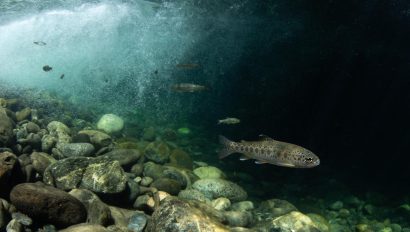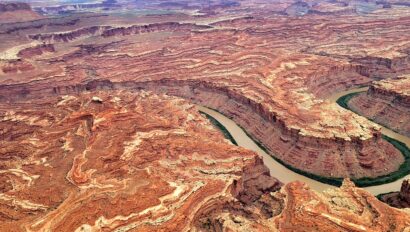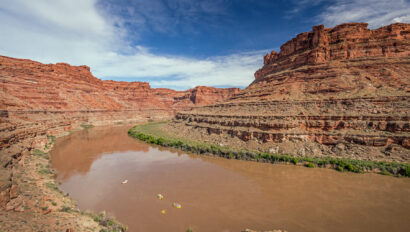What This Year’s Snowpack Means for the Colorado River
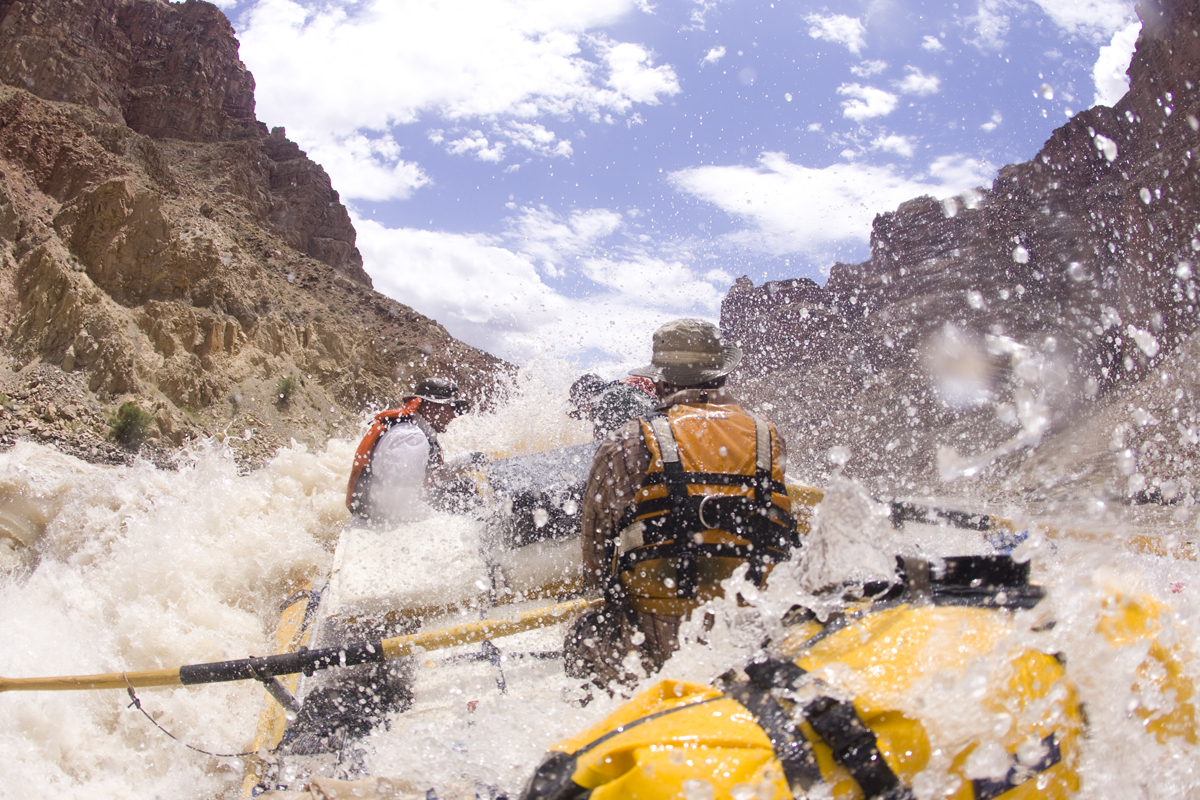

As much as 75 percent of water supplies in seven western states comes from snowmelt. It’s that melting snow that turns icy trickles of mountain streams to surging rivers in spring and delivers water to more than 40 million people in the Colorado Basin. So after more than two decades of drought, snowpack like we’re seeing this spring is welcome and worth celebrating.
A Memorable Year for Colorado River Rafting
Utah received more snow than 2021 and 2022 combined and toppled its 40-year statewide snowpack record that was set in 1983—a year most longtime river runners still talk about. This is the season the Colorado peaked at 104,000 cfs in Cataract Canyon and further downstream is best-known for river guide Kenton Grua’s record-breaking run through Grand Canyon in The Emerald Mile.
The snowpack for the entire Upper Colorado River Basin is also holding above average, so it’s hard for river runners not to be stoked about an outlier year like 2023. The free-flowing stretch of the Colorado River through Cataract Canyon is poised to be a highly memorable whitewater year, with a peak flow currently predicted at 68,000 cfs. And a little further north, the snowpack in the Yampa River Basin is still tracking closely with the near-record-high 2011 rafting season. On this free-flowing tributary of the Colorado, paddlers can all expect a full season of rafting, lasting into early July. Additionally, river runners and Grand Canyon advocates are celebrating the recent “decision by federal water managers to unleash a three-day pulse of high water from Glen Canyon Dam to rebuild beaches and improve environmental conditions on the Colorado River.” Federal agencies announced the decision to go-ahead with the high-flow experiment, which is scheduled to start Monday, April 24. The move allows dam operators to open bypass tubes and roughly quadruple the river’s flow to 39,500 cfs.
So, the Grand Canyon is getting a boost and as far as rafting is concerned, this could be the year to make those bucket list trips come true. But does a winter like this one, that has broken records in states like Arizona, California and Utah, do anything to bring lasting relief to the parched Colorado Basin? The answer deserves a little more detail.
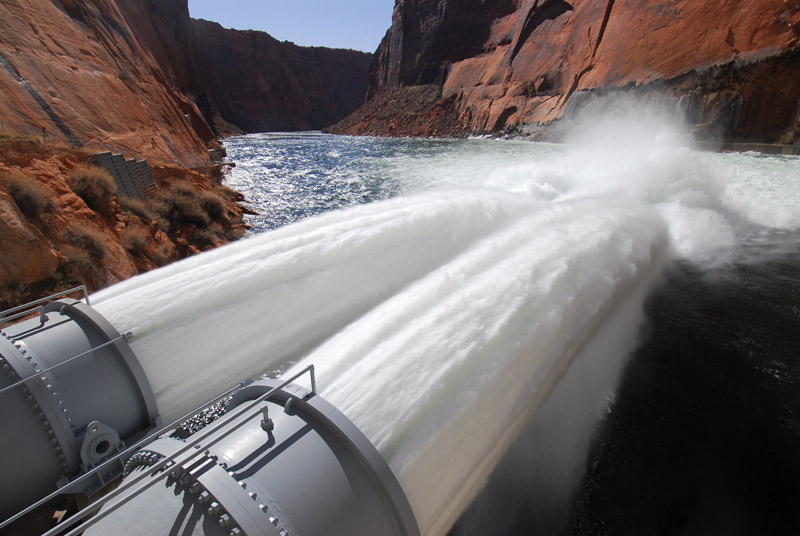
One Good Year is Better Than the Alternative
“It’s definitely helpful. It’s way, way better than the alternative, but I think that the decision makers around water in this system are not distracted by one good year,” says Anne Castle, Senior Fellow at the University of Colorado’s Getches-Wilkinson Center and the U.S. Commissioner to the Upper Colorado River Commission. Speaking for herself only and not for the Commission, Castle said, “We haven’t solved the underlying problem. We still have water usage that greatly exceeds supplies. I think for the most part, and this is not universal, but generally, the decision makers are not thinking we can take our foot off the gas pedal.”
The basin’s two largest reservoirs, Lake Powell on the Arizona-Utah border and Lake Mead on the Nevada-Arizona border, would need to see this kind of snowfall for multiple years to recover after decades of over allocation and drought. And it’s just that kind of use it, or lose it logic that got us into this situation in the first place.
“We’ve got a very volatile system, we also have empty reservoirs at the moment. If you had full reservoirs, then you’d have some cushion, but we don’t,” Castle says. “Until our reservoirs have a more comfortable amount of storage again, we’re going to be much more subject to the natural hydrologic volatility.”
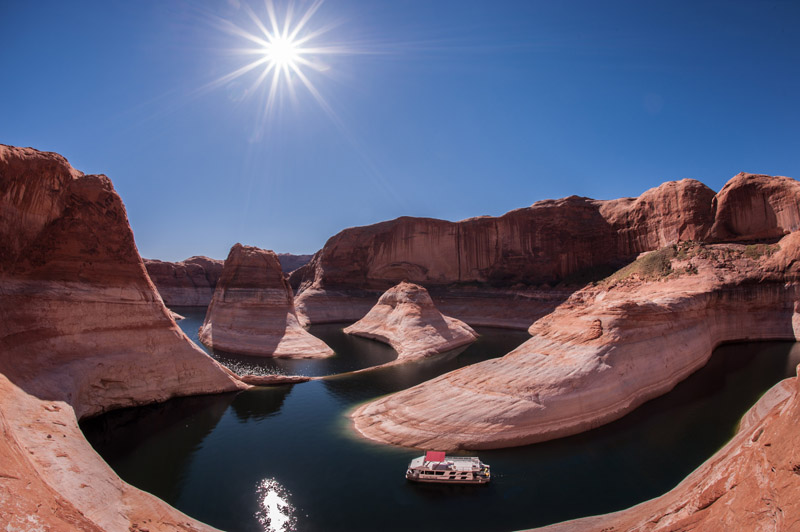
Together, Lake Powell and Lake Mead reservoirs hold about 83% of the total storage capacity for the Colorado Basin and as of this month, Lake Powell is at about 23% capacity, while Lake Mead is at about 28%, according to the Bureau of Reclamation. An acre-foot, or 326,000 gallons, is about enough water to supply the indoor and outdoor needs of two to four U.S. households a year.
“It is going to take, at a minimum, five or six really good years in a row, and maybe as many as 10 or 15 to refill the reservoirs,” says Castle. “And, because we have a deficit between supply and demand, however much water we’ve got in the savings account, we’re regularly drawing it down. So this winter isn’t enough to even fill that gap.”
And beyond the deficit, a big snowpack doesn’t automatically equate to more water in the basin. It’s also about what happens to that snow. Castle says, “We’ve seen this movie before. We’ve seen good snowpack literally evaporate and give us a less than average year.”
April marks the point when snowpack hits its peak each spring. SNOTEL data collected by the National Resources Conservation Service as of April 12 shows the total snow water equivalent—the amount of liquid water in snow—in nearly every major river basin across the West are above average to well above average, especially in Basin states like Arizona, California and Utah, that have seen some of the most precipitation in decades.
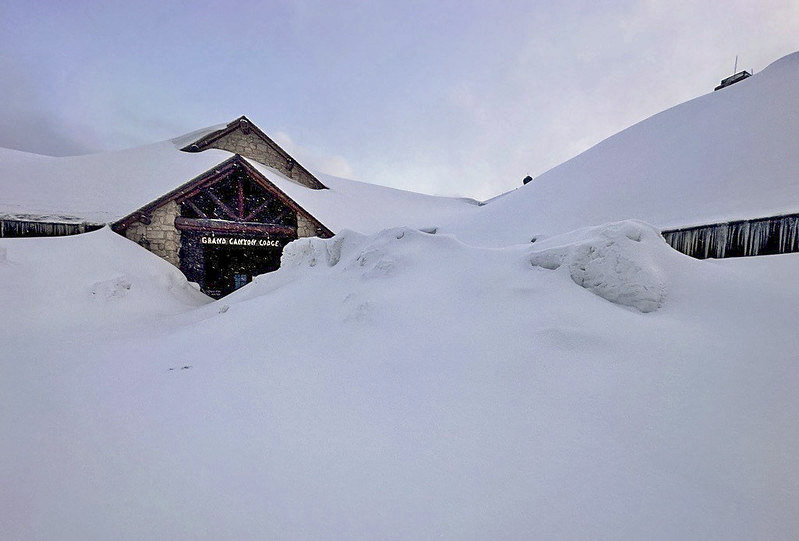
As temperatures heat up, snowpack melts, flowing into rivers, reservoirs and seeping into the ground. Snowpack essentially acts as a bank of water for drier seasons throughout the year, but because climate change has actively shifted our reality, we’re seeing earlier, warmer springs and faster snowmelt. As the climate warms, there is a longer growing season for natural vegetation, so it absorbs more of the natural runoff that it otherwise would have. And warmer temperatures dry out soil more than otherwise, so more of the runoff goes to replenishing the soil moisture. Those warmer, drier temperatures can also escalate evaporation in reservoirs, which accounts for the loss of about 1.5 million acre feet each year. In addition, dirt kicked up by winds, dusts snow in the mountains, which ramps up melting because it absorbs more of the sun’s heat. Research has shown that dust on snowpack can shorten the duration of snow cover by 21 to 51 days.
And all of this is unlikely to change. Many experts now say that what we’re facing in the West goes beyond drought. While megadroughts, like what is happening in the Colorado Basin, “are discrete episodic events, aridification is a transition of the climate and hydrology of a region to drier conditions. In terms of the human timescale, this transition represents a more permanent change.”
Which is why on the heels of this record-breaking winter, the Biden Administration announced a series of alternatives for operations on the Colorado River this week, moving one step closer to imposing unprecedented cuts in how much water Lower Basin States (Arizona, California and Nevada) can continue to pull from the river. In their review, the administration also raised the possibility that these cuts may be distributed in ways that contradict long-standing water rights that favor powerful farming regions.
Failure Not an Option
“The Colorado River Basin provides water for more than 40 million Americans. It fuels hydropower resources in eight states, supports agriculture and agricultural communities across the West, and is a crucial resource for 30 Tribal Nations. Failure is not an option,” said Deputy Secretary Tommy Beaudreau about the administration’s draft alternatives.
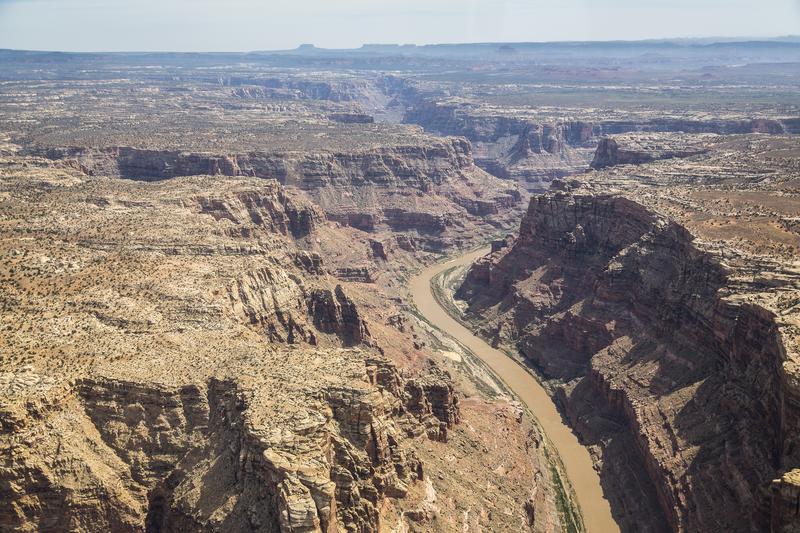
The alternatives came as administration officials kicked off a tour along the Colorado River with a bipartisan delegation of senators to continue to push for an agreement on how to address the crisis and cut two to four million acre feet from current usage and announced “the largest investment in climate resilience in the nation’s history, providing much-needed resources to enhance the resilience of the West to drought and climate change, including to protect the short- and long-term sustainability of the Colorado River System,” through the Bipartisan Infrastructure Law and the Inflation Reduction Act.
After input from the Basin States, Tribes and other stakeholders, the administration’s review proposes three alternatives.
- One option would strictly adhere to the “law of the river,” continuing to give priority to agricultural regions in California, which would adversely affect Arizona and reduce Nevada’s share. California would be largely unaffected by this move, while cutting off much of the water supply to other Lower Basin states.
- Another would depart from historic agreements and equally distribute cuts of up to 2 million acre-feet across all users in the Lower Basin states.
- And the third option, which officials warn would be the worst of all, is to change nothing. Bureau of Reclamation Commissioner Camille Calimlim Touton said in a conference if no action is taken, “we can expect water levels to continue to decline, threatening the operations of the system, and the water supply of 40 million people.”
“Drought conditions in the Colorado River Basin have been two decades in the making. To meet this moment, we must continue to work together, through a commitment to protecting the river, leading with science and a shared understanding that unprecedented conditions require new solutions,” Touton said in a statement.
Federal officials have stressed throughout the process that the goal is to continue to deliver water to communities throughout the basin, including Native American Tribes, cities and towns, agriculture and ecosystems. Just how much, remains to be seen. In addition to settling on an approach for the next three years, water managers will also be negotiating new rules for dealing with shortages after 2026, when the current rules expire.
“My vision is that we come to a set of operating rules that have us living within our hydrological means. We have not been doing that for the past 20 years, but it’s a vision of sustainability,” says Castle. “That could look different in different places, but it’s a mentality of collective good versus maximizing your own benefit. I would like to see more people give permission to their elected leaders to make those kinds of decisions that result in a reduction of the amount of water that we each get to use.”
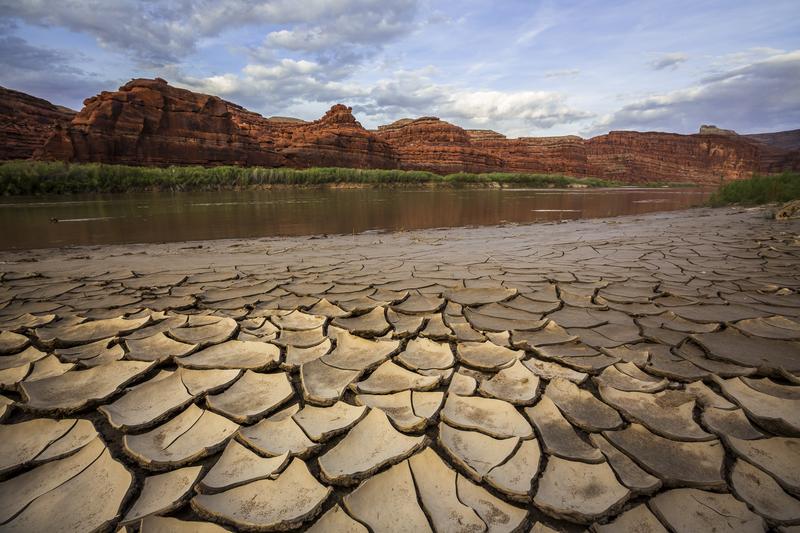
Because at the end of the day, we simply have to change. Regardless of snowpack, we do not have enough water to go around as we have been and we simply have to approach this challenge with our collective humanity at the forefront.
“We have faced crises in the Colorado River system before and successfully navigated them. There are a lot of smart people who are in positions of responsibility, and they know exactly what needs to happen,” says Castle. “They’ve got fiduciary duties to their constituencies that are part of the equation, but at the end of the day, they know what needs to be done. So I think that’s a reason to be optimistic.”
And as Colorado Senator Michael Benet said with other decision makers last week, “The future of the American West is at stake.”
The public has an opportunity to participate in the federal comment period until May 30, 2023. From there, we can expect the federal agencies to make a decision on next steps by August.
Read the Full Investigative Series:
Part 1: Navigating the Uncertain Future of the Colorado River
Part 2: A Thirsty West: How Did We Get Here
Photos: Cataract Canyon rafting – Justin Bailie; Colorado River for a high flow experiment – USGS; Lake Powell Reflection Canyon – NPS Photo/Gary Ladd; Grand Canyon Lodge winter of 2022/23 – NPS Photo/E. Shalla; Colorado River – Whit Richardson; Parched shore along the Colorado River – Whit Richardson
Related Posts
Sign up for Our Newsletter

